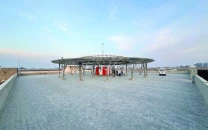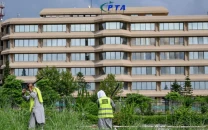No plans in sight to tackle upcoming heatwave
As climate change shifts weather patterns, disaster prevention authorities and hospitals lack a strategy

Despite the fact that Khyber-Pakhtunkhwa is highly prone to natural disasters, the provincial government's efforts towards combating climate change appear to be limited to lip service only. As the arrival of April marks yet another spell of extreme heat, the authorities' plan of action is restricted merely to advising people to cover their heads, avoid going out in the sun, and drink plenty of water.
According to meteorological experts, Khyber-Pakhtunkhwa (K-P) is likely to experience temperatures up to 47 degrees Celsius during June and July this year. It is predicted that from April to May, the temperature will rise to 41 to 43 degrees Celsius. This sudden change in weather can cause a variety of health issues among locals. However, the K-P government has not yet prepared any plan for tackling the looming heatwave, with major hospitals still unprepared.
A report published by the K-P Provincial Disaster Management Authority (PDMA) revealed that from April 12th to 21st, despite no heatwaves, severe rains and weather changes instigated thunderstorms, storms, and flash flooding across the province, resulting in 60 deaths and dozens of injuries. The report also stated that a total of 11 houses were damaged due to the rains. Such incidents were reported across various districts of the province, including Charsadda, Khyber, Shangla, Buner, Lower Chitral, Swabi, and Kola-Palas.
Apart from this, areas like Chitral face an added risk of flooding as peaking temperatures in May and June could potentially cause glaciers to melt and river water levels to rise. However, despite the looming risk of disaster, no concrete steps have been taken to tackle the impending environmental hazard. Despite the K-P government's claim of developing the province's first climate change policy, practical steps to cope with climate change remain measly.
Salar, a resident of Charsadda living near the Kabul River, told The Express Tribune that for the first time in his lifetime, the spring season was either hard to observe, or did not arrive at all. "The increase in temperatures and decrease in winter duration have altered the timing of the seasons and rainfall patterns. The hailstorm in April, which typically brings large-sized hailstones, has raised concerns in cities like Peshawar," said Salar.
According to Dr Muhammad Akmal, a climate change expert and former Director of the Climate Change Center at the Agricultural University Peshawar, the province's plain and mountainous areas will experience a rapid increase in temperatures over the next five to 10 years.
"The monsoon rains, which typically occur in June and July, are now expected to extend into April and March by 2030. Similarly, the winter rains, which used to occur from September to January, have decreased to a duration of less than five months, and it is predicted that the winter rainfall pattern will cease to exist by 2030," revealed Dr Akmal, who identified concrete roads, industrialisation, elimination of green belts, vehicular emissions, unchecked use of air conditioning, deforestation, and plastic use as the key factors contributing to climate change and rising temperatures in K-P.
Reportedly, the K-P Health Department has recently developed a 'Climate and Health Adaptation Plan'. The plan warns that if timely measures are not taken to address climate change and its impacts, approximately 1.8 million people in the province may face health issues in the coming years. The plan further predicts that in the coming years, K-P may experience a 30 to 40 per cent increase in malaria and dengue fever cases, as well as a 20 per cent increase in cholera outbreaks due to rains and floods.























COMMENTS
Comments are moderated and generally will be posted if they are on-topic and not abusive.
For more information, please see our Comments FAQ